Rain Gardens
Posted:Rain gardens are a simple, elegant solution to solving drainage issues on properties and water quality issues state-wide. A rain garden is a low area planted with deep rooted native plants that absorbs water running off of hard surfaces such as driveways, roads, roofs, and parking lots.
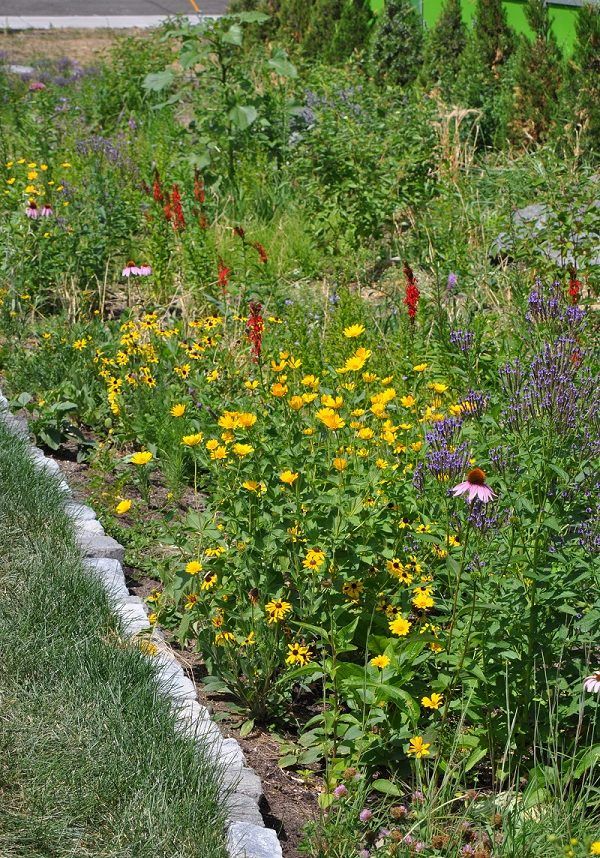
Rain gardens provide benefits to homeowners
- Helps keep foundations and basements dry
- Accepts and absorbs run-off of snow melt water
- Holds and handles surges of rainwater during storms
- Attractive, low maintenance landscape feature with blooming plants
We all live on a shoreline. Whenever it rains the water from our properties runs into the streets. Acting like creek beds, our streets and street sewers rush warm, polluted water from our properties into local bodies of water. Here in Minneapolis all of the water that leaves our properties and enters street sewers eventually ends up in a lake, creek, or the Mississippi River.
Rain gardens also provide ecosystem benefits
- Cools, cleans, and filters water before it enters local waterways.
- Deep rooted perennial plants hold soil and prevent erosion.
- Reduces need for mowing when placed in lawns.
- Provides habitat for butterflies and birds.
- Reduces or eliminates run-off.
Moving all of this warm, polluted water into lakes, creeks, and rivers damages water quality by reducing oxygen levels. When oxygen levels are reduced so are the numbers of healthy fish, aquatic birds, and plants. Everything we do to reduce run-off from our properties improves local water quality, thereby improving the quality of our lives.
How To Choose a Site
Start by observing water flow on your property. Do you have water seeping into your basement? Does water pool during a rainstorm or when snow is melting? Does more water flow towards the front, middle, or rear of your property? Do you have gutters to direct the flow? Answering these questions will help you choose a site for your garden.
It is important to understand that whenever we infiltrate water into the ground within 10’ of our foundation, we’re asking for trouble. Water infiltrates the ground at an angle. When downspouts or rooflines direct water within 10’ of our foundations, we can easily end up with water in the basement. This is why rain gardens must be sited at least 10’ from the foundations of homes or buildings with basements. Site rain gardens 35 feet or more away from septic system drain fields and 50 feet or more away from drinking water wells, and never directly on top of utility lines. Before excavating, call Gopher State One Call (800) 252-1166 to locate electrical, gas or telephone lines.
Low areas in the lawn that tend to pool can be excellent spots for a rain garden installation. We look for low areas that are near down spouts or the down-slope edge of driveways and sidewalks so that water will flow easily into the rain garden. Sometimes shallow trenches can be dug or drain tile can be used to direct water into a rain garden.
Rain Garden Installation at Seward Coop
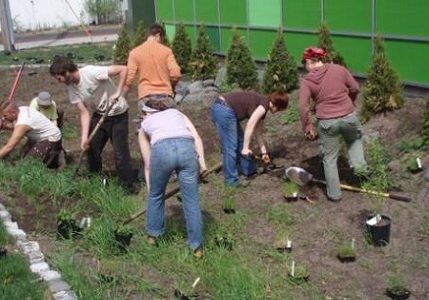
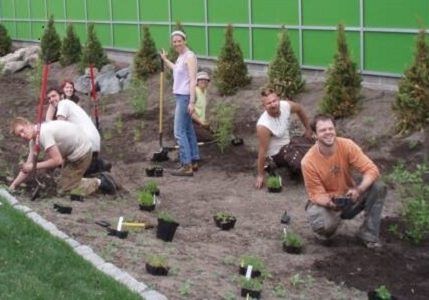
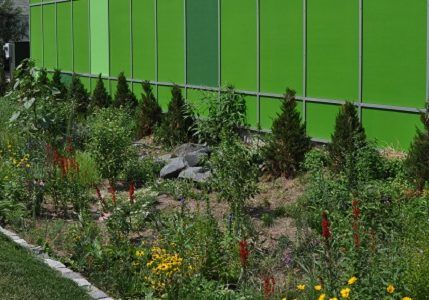
Size and Shape
Rain gardens can be any size or shape. We often like to make rounded, half moon, or kidney shaped rain gardens.
Get out an extension cord or hose to lay out and play with the shape of the garden before you start digging.
A quick sketch may also help you determine the most aesthetically pleasing shape for your rain garden.
Rain gardens are typically capable of handling run-off from hard surfaces that are up to 3-4 times the size of the garden.
If you have a very large roof or driveway, you may want to install more than one rain garden such as having one near each gutter downspout.
The type of soil you have may influence the size of rain garden you grow:
- In heavy clay soils that infiltrate water slowly, you may need a larger size rain garden in order to infiltrate rain water into the ground rapidly enough to keep up with storm surges.
- Sand, loam, and silty soils tend to drain much more efficiently.
You can test the drainage capacity of your soil by digging a wide hole 10 inches deep and filling it with water:
- If the water disappears within 48 hours, the soil in the site is likely suitable for rain garden installation.
- If it takes more than 48 hours to infiltrate, you may want to double the size of your rain garden in order to accommodate water flow.
Excavation and Soil Prep
Rain gardens are typically dug in between 4 and 18 inches. You’ll want to excavate enough soil so that your garden has a flat bottom, which will encourage faster water infiltration. If you’re excavating in a hillside, you can use the soil you dig out to form a berm on the down-hill side of your rain garden. Excavate 3-4 inches deeper than you want the finished level to be. After excavation install 3-4 inches of a mixture of 1/3 composted cow manure and 2/3 shredded hardwood mulch. We get our mulch and manure mixture from Kern Landscape Resources in St. Paul; they can deliver to your site.
Once you’ve installed the fresh mulch & manure mixture, turn the soil in the bottom of the bed with a shovel. This will break up any compaction layer and incorporate organic matter that will grow beneficial soil fungi which will promote deep rooting and soil structure for efficient water infiltration. Once you’ve turned the soil you can add in another inch of manure & mulch mixture to top dress and even out the soil.
Plant Selection
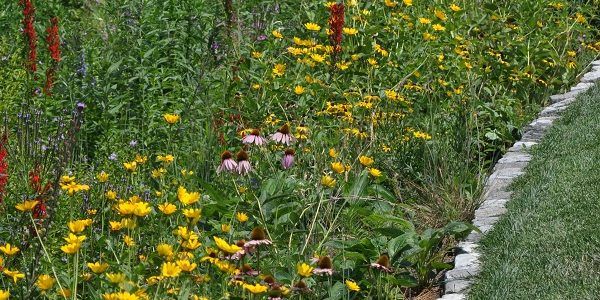
Choose a palette of contrasting textures, varying sizes, and bloom times that span the growing season.
There are excellent plant choices for both sunny and shady rain gardens. We aim for about one native perennial plant per 1.5 square feet of garden space. Generally speaking, you’ll want to plan for taller plants in the middle of the rain garden and shorter plants around the edges. If the garden has a “back” to it, place the taller selections towards the back.
Plants toward the middle of the rain garden should be able to take inundation with water while plants installed on the sides or berm should be able to handle well drained conditions. Several of the same plants that grow near shorelines do very well in rain gardens. You can incorporate trees and shrubs that can handle water into your rain garden as well.
Here are some of our favorite plants for rain gardens:
Sunny Rain Garden Plants
Joe Pye Weed: 5-8’ tall. Monarchs adore this summer-fall bloomer. Joe Pye is great in a rain garden or low-wet spot in the garden. Grows well in full sun or part shade. Every rain garden needs Joe Pye Weed.
Sweet Grass: 12-24” Excellent rain garden or moist soil spreader. Smells like spring. Strong spreading plant, loves rain garden settings.
Bee Balm: 2-3' Lavender-pale pink flowers growing in dense, round clusters. Summer blooms amassing a flurry of bee activity. Attracts butterflies and hummingbirds.
Aster: 4-5’ Gorgeous purple-blue flowers with yellow centers. Autumn blooms attract butterflies and bees. Perfect for end of the season blooms.
Zig-Zag Goldenrod: 2-3' Brilliant yellow flowers along slight “zigsag” stem in Fall. Native to woodlands and woodland margins. Strong rain garden spreader.
Cup Plant: 6-8’ Large bright yellow flowers in July-September. Leaves form "cups" along stems that collect water. A favorite of Goldfinches. Strong spreader, will colonize wet to well drained areas. Good in large rain gardens.
Yellow Coneflower: 5’ tall. Yellow blooms bring in the butterflies, summer to fall.
Pale Purple Coneflower: 3-4' Pink-purple flowers on erect stems, blooms in mid-Summer. Attracts butterflies, bees, and hummingbirds. Good in the sunny border of rain gardens.
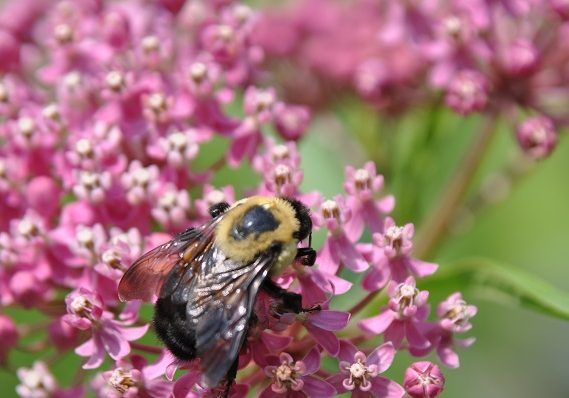
Swamp Milkweed: 2-6’ tall. Pink blooms in summer are bees favorite. Milkweed is essential breeding ground for monarch butterflies. A must-have in the rain garden and butterfly garden.
Prairie Blazing Star: 2-4’ Abundant and spectacular magenta-purple flowers feather from a sturdy stalks, Summer to Fall. Butterfly magnet. Plant with Big Bluestem to protect from wind.
Meadow Blazing Star: 4-6’ tall. Monarchs line up all day for this full sun - part shade favorite. Purple blooms look like starbursts. If you want to see monarchs, this is a guaranteed winner. Best of the blazing stars for attracting pollinators. Plant in groups of at least 5 plants.
Veronicastrum: 3-6’ White candelabra-like spikes of densely packed small blooms that open from the top down mid-summer. Found in wet meadows and forest borders. Excellent rain garden spreader.
Ironweed: 4-6’ Magenta flowers are a rare color in late summer. Strong, sturdy stem with excellent posture. Native to marshes and wet prairies. Host plant to the American Painted Lady butterfly. Excellent rain garden spreader.
Big Blue Stem: 5-8’ Fine, blue-green foliage that serves as a backdrop to taller wildflowers - turning a rich, rust-colored hue in fall providing. Supports floppy plants, provides visual interest between bloom periods and in winter. Female bumble bee queen nest at the base of bunch grasses where they will be protected until they emerge in the spring. Stalks shelter pollinators in larval stages and are overwintering habitat for a variety of wildlife. Spreads well in the bottom of sunny rain gardens.
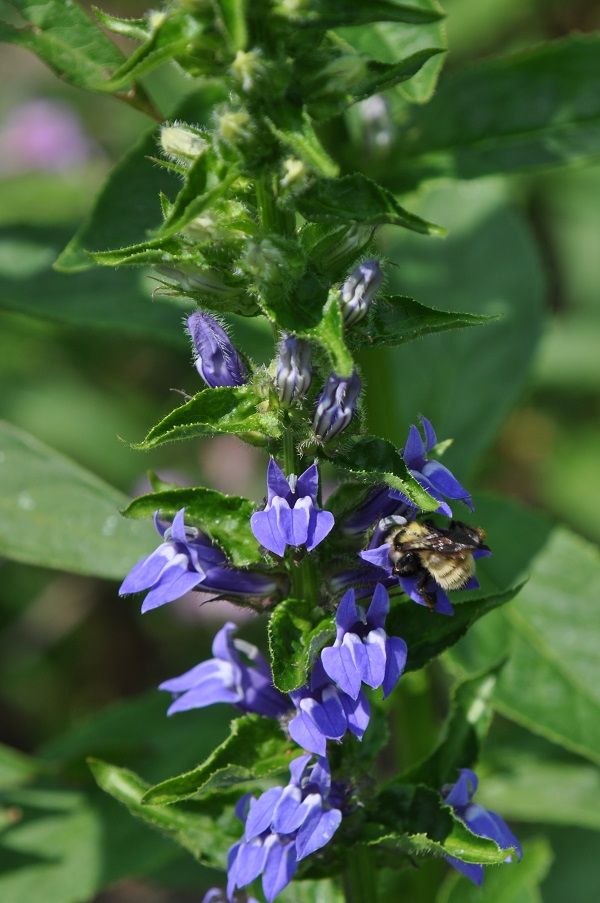
Shady Rain Gardens
Virginia Bluebells: 18-24” tall. Delicate texture. Amazing blue blooms in the spring.
Cardinal Flower: 24-36” Bright cardinal red blooms Summer to Fall. Attracts hummingbirds and butterflies.
Blue Lobelia: 24-26” Deep blue blooms late summer to late fall. Spreads readily by seed. Attracts hummingbirds.
Wild Geranium: 12-24” Must have, purple-blue blooms in the spring. Good for mason bees. Rain garden border plant.
Ostrich Fern: 2-4’ Large feather-like fronds growing in a vase shape. Wonderful in a massing or as a specimen. Strong spreader, great for rain garden bottom.
Pennsylvania Sedge: 6-12” Elegant arching dark green foliage. Excellent for massing in woodland gardens. Spreads in the bottom of rain gardens to create a dense ground cover.
Blood Root: 6-9” White blooms and unique broad foliage. Early spring bloomer. Native to deciduous woodland. Best in the top or sides of the rain garden.
Foam Flower: 6-12” White or pink delicate blooms in May. Heart shaped leaves. Rabbit and deer tolerant.
Virginia Waterleaf: 12-30”, strong spreader, good for bumble and honey bees.
Heartleaf Aster: 12-24” Abundant blue flowers. Fantastic bee forage in Fall. Found along woodland margins.
Rain Garden Shrubs
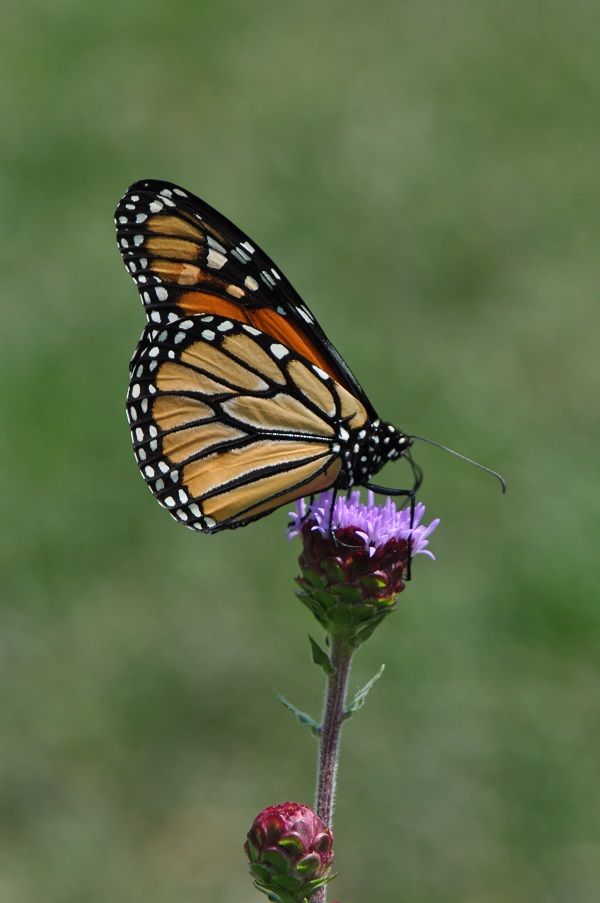
Pussywillow: up to 12’ tall. Very important early season pollen source. Fast growing, loves to have its feet wet.
Dogwood: up to 10’ tall. Dogwood love low-wet areas and shorelines. White spring blooms. Often reblooms summer and fall. Every rain garden needs dogwood. Red twig, grey, and pagoda are excellent rain garden choices.
Willow: up to 12’ tall. Very early blooms are incredibly important for bees. Sometimes blooms in Feb or March in years with early spring. Perfect example of how wind pollinated shrubs are important food sources for bees. Excellent rain garden shrub.
Highbush Cranberry (Viburnum trilobum): While not a true cranberry, this shrub produces delicious edible fruit that are tart and sweet and can be easily found dried on the vine for a trail snack. Different varieties grow between 6’ and 13’ tall. Its height combines with its shade tolerance to make viburnum an excellent under-story shrub in the food forest.
Chokecherry (Prunus Virginiana): An absolute bird magnet when the cherries begin to ripen. This 8-12’ tall shrub forms dense thickets especially in clearings near bodies of water. While the name sounds alarming, these cherries have a delicious bitter cherry taste. Best if ripened till the cherries are purple black. Will rapidly colonize a rain garden setting.
Black Cap Raspberry (Rubus occidentalis): Amazingly delicious, every food forest needs a few stands of black caps. High wildlife value, easy to grow, forms dense thickets. Pies, jams, berries, my favorite berry to find on a summer day.
Gooseberry (Ribes missouriensis): This tart fruit also known as a currant grows across the US. Eat raw or in a jelly, jam, pie, or tart.
Service Berry (Amelanchier alnifolia ‘Regent’): 4-6’ tall shrub that produces berries in June and readily attracts birds. Lovely airy form of the shrub allows for fruiting ground cover such as wild strawberry beneath. Excellent for the sun – part shade rain garden.
Lowbush Blueberry (Vaccinium angustifolium): A common treat in northern MN forests, the lowbush blueberry is one of the most prolific berries in northern woodlands. High wildlife value, excellent human food source.
Elderberry (Sambucus canadensis): It’s a race to harvest any elderberries before the birds. High in antioxidants, this sweet-tart fruit should be harvested before the seeds get too big inside the berries. Perfect rain garden shrub.
Rain Garden Trees
Larch (genus Larix): the larch is a graceful conifer with soft, short needles. Loving wet soil, this native tree grows perfectly in a rain garden. Drops its needles every fall. Soft, delicate aesthetic. Pink flowers grow into cones. Grows 60-100 feet tall.
River Birch: Betula nigra, native to southern MN wetlands, this tree loves having its feet wet. Found on river banks and flood plains, birch thrive in a rain garden setting. Can be single or multi stemmed. Grows 80-100 feet tall.
Hackberry Celtis occidentalis: native tree beloved by birds for the fall fruit. Host plant for the hackberry emperor butterfly. The bark on hackberry is one of its most attractive features with distinctive grey brown ridges and valleys. Excellent rain garden tree that tolerates urban conditions.
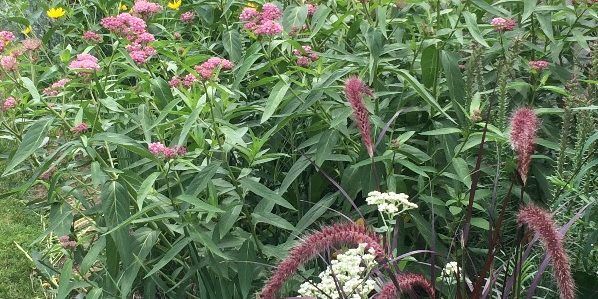
Downy Serviceberry, Amelanchier arborea: is a year-round beauty. Showing white flowers in spring, red berries for birds and people to eat in summer, stunning fall color and soft gray bark in winter. Perfect rain garden understory tree or large shrub.
Swamp White Oak, quercus bicolor: is an excellent shade tree that can be planted in the depths of a rain garden. Fast growing oak that can reach 80’ tall. Can live up to 300 years.
Every rain garden needs Joe Pye Weed.
